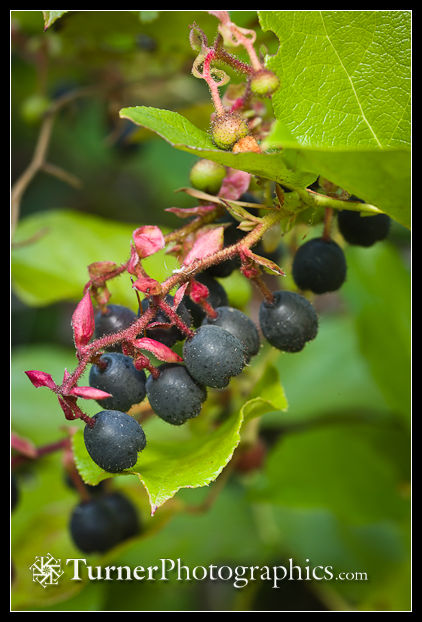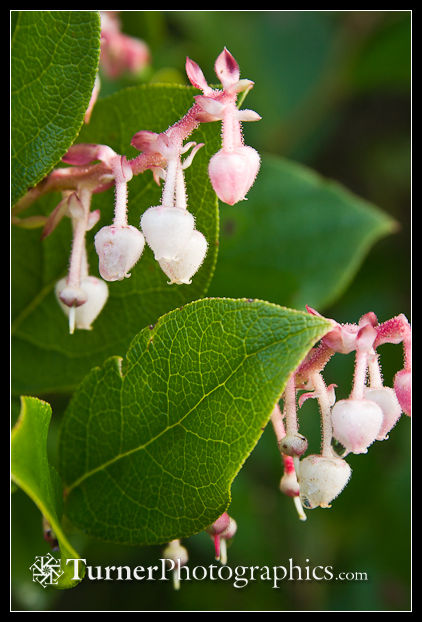Plant of the Month: Salal
 Thick, leathery, glossy, evergreen foliage makes salal (Gaultheria shallon) desirable both in the garden and in the florist’s palette. This time of year you won’t find either flowers or fruit on salal — those will come in the warm months — but the foliage provides a comforting green layer at the edge of woodlands. Salal is particularly common along the Pacific coast from southeast Alaska all the way down to Santa Barbara county, California. It also grows up into the middle elevations of the Cascade and Coast Ranges.
Thick, leathery, glossy, evergreen foliage makes salal (Gaultheria shallon) desirable both in the garden and in the florist’s palette. This time of year you won’t find either flowers or fruit on salal — those will come in the warm months — but the foliage provides a comforting green layer at the edge of woodlands. Salal is particularly common along the Pacific coast from southeast Alaska all the way down to Santa Barbara county, California. It also grows up into the middle elevations of the Cascade and Coast Ranges.
..about the trash can review
Salal forms dense thickets, sometimes head-high, that are nearly impenetrable by us mere humans. Just try bushwhacking through the stuff some time when you’re out on a hike near the coast. Let me know if you’re successful. That makes salal a great habitat plant for wildlife for it creates myriad sheltered hiding places for birds and small mammals. Even larger mammals like elk and deer take shelter in or behind salal thickets. This first photo shows salal blanketing the coastal bluff at Shi Shi Beach in Olympic National Park.
 The dark purple, nearly black salal fruit which ripens from July to September is eaten by many mammals and birds, including band-tailed pigeons, wrentits, ruffed, spruce, and blue grouse, and numerous songbirds. According to the US Forest Service, “In some areas, blue grouse chicks exhibit a marked preference for salal fruit, and both chicks and adults consume large numbers during July and August.”
The dark purple, nearly black salal fruit which ripens from July to September is eaten by many mammals and birds, including band-tailed pigeons, wrentits, ruffed, spruce, and blue grouse, and numerous songbirds. According to the US Forest Service, “In some areas, blue grouse chicks exhibit a marked preference for salal fruit, and both chicks and adults consume large numbers during July and August.”
Salal fruit is also tasty to humans and was an important part of the diet of the Pacific Northwest native populations. The fruit has been eaten both fresh and dried into cakes for centuries. It’s sweet and delicious, with a somewhat leathery outer skin. You can cook them into jam, jelly, or sauces. There are a couple of recipes in Jennifer Hahn’s book, Pacific Feast: A Cook’s Guide to West Coast Foraging and Cuisine, or you can find some with a web search for “salal recipes.”
 Beginning in April salal bushes are covered with thick sprays of pendant bell-shaped white or pale pink blossoms. Gaultheria shallon is a member of the Ericaceae or heather family and the family heritage is obvious when you look at the flowers. Hummingbirds may feed on salal nectar but it’s not among their primary food sources.
Beginning in April salal bushes are covered with thick sprays of pendant bell-shaped white or pale pink blossoms. Gaultheria shallon is a member of the Ericaceae or heather family and the family heritage is obvious when you look at the flowers. Hummingbirds may feed on salal nectar but it’s not among their primary food sources.
As a garden plant salal can be slow to establish but will eventually grow to full size like in the wild. We planted little starts from four-inch pots and waited a long time for them to get going and later planted gallon-size plants and got results a lot faster. Salal was one of the prized plant collections by explorer David Douglas, who carried seeds back to Britain in 1828 where it was then introduced to cultivation. Florists use the foliage as a long-lasting component in their arrangements. There’s a large business of people harvesting wild salal for the florist trade.
If you’re interested in a lengthy literary story of salal and how it’s tightly woven into Northwest culture, check out the book Salal: Listening for the Northwest Understory by Laurence Ricou.
More salal photos are on my wildflowers website.
Disclosure: I earn a few pennies if you follow the Amazon book links and make a purchase.


Pingback: Salal Jam (Improved) | Blackcap Blog